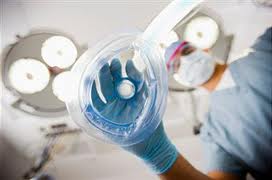
There are four basic choices of anesthesia in plastic surgery ranging from topical, local, IV or conscious sedation and general anesthesia. Here are some basic concepts of how they work and when they are most useful.
Topical anesthetics are based on the application of creams that contain various types of well known anesthetic agents. They need time to work to penetrate the skin so ideally they should be applied at least 30 to 45 minutes before the procedure. To enhance their absorption the area may be covered or wrapped with a plastic dressing to allow maximum penetration of the active agents in the cream. They will make the skin numb but not tissues underneath it. Therefore, they are only good for procedures like laser hair removal and light to medium-depth laser skin resurfacing. They may also help lessen the feeling of injection needles as they pass through the skin.
Local anesthetics have been for a long time and just about everyone has received a local anesthetic injection for some procedure, often dental in nature. In plastic surgery, the local anesthetics used almost always also contain epinephrine to decrease the bleeding at the surgical site. Once injected local anesthetics take about 7 to 10 minutes to exhibit their maximal effects. Local anesthetics do burn on injection due to the low pH of the solution. (acidic) When buffered with sodium bicarbonate they are much less painful on injection. Their numbing effect will last up to 2 hours unless a more long-lasting agent is used that create numbness up to 24 hours. While local anesthetics are very effective, patient soften feel more procedures can be done under local anesthesia than really should be done. Fixing an earlobe tear, removing a mole or small skin cancer or even upper eyelid surgery can be comfortably done under local but bigger procedures like facelifts, breast augmentation and liposuction (even though they may be marketed this way) should give one pause. You want to make sure that the anesthetic selection will not limit the extent of the procedure and the final result.
IV sedation, also known as twilight or conscious sedation, has come a long way in the past 25 years. The drugs available today are so good that they can have an effect on the patient like they feel like they have had a general anesthetic. (no memory) Sedation drugs can include just oral (pills) or different concoctions given through an IV. Oral sedation is good to take the edge off before a procedure that is using a topical or local anesthetic and the pills should be taken one hour prior to the procedure. IV sedation can range from very light to deep based on the drugs and their dosages used. It can be a difficult choice to choose between sedation and general anesthesia for many procedures as there is a lower risk of nausea and vomiting after sedation and one may feel like they wake up quicker after it. The best way to think of sedation is that it is an extension of a local anesthetic. If getting the area adequately numb is the issue, then sedation can very comfortably get one past the injections. This approach can be very effective for isolated face or body areas but one should not think of larger surface areas such as in multiple areas of liposuction, a tummy tuck, or even a more extended facelift as good for a sedation approach. This does not mean that some doctors do not do them but it pushes the balance between getting a comfortable surgical experience and the maximal result simultaneously.
General anesthetics are well known and the difference between them and a deep sedation is a fine line. The difference is that in general anesthetics patients lose control of their breathing and the anesthesiologist must take control. This is done historically with an endotracheal (ET) tube (between the vocal cords and into the lungs) or more commonly with an laryngeal mask. (LMA) With the exception of rhinoplasties and facelifts, most general anesthetics in elective plastic surgery today are done with an LMA. This produces less throat soreness afterwards as the mask stays well above the vocal cords in the back of the throat. General anesthetics provide comfort for every procedure to be performed. The aggressive use of anti-nausea drugs before, during and after a general anesthetic dramatically decrease the likelihood of after surgery nausea and vomiting, the most dreaded fear of most patients when considering a general anesthetic.
For the administration of deep IV sedations and general anesthetics, a board-certified anesthesiologist is the safest approach although the use of certified nurse anesthetists (CRNA) is permitted in some states. For procedures that only need topical, oral or local anesthetics, your plastic surgeon will give the injections or write a prescription for the anesthetic medicine.
Dr. Barry Eppley
Indianapolis, Indiana


